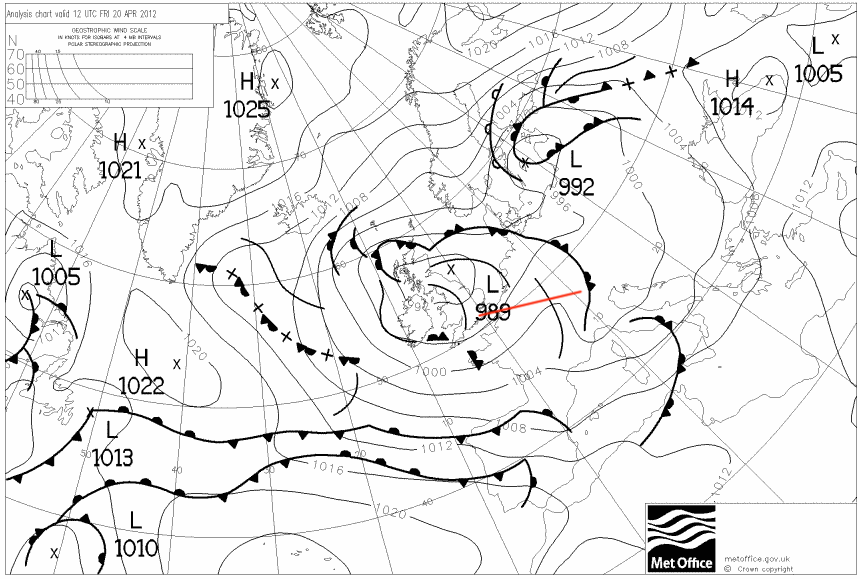
Trip to Friedrichshafen - April 2012
This article describes a very straightforward IFR (airways) trip from Shoreham (EGKA) in the UK to Friedrichshafen (EDNY) in southern Germany, for the Aero 2012 exhibition, and back 2 days later.
Procedurally, the flight was very similar to other airways flights I have done. Other VFR and IFR trip reports can be found here.
I don't write up trips unless there is something new to write about, and I thus hesitated on whether to do this one which was essentially a repeat of this 2007 one and this 2010 one. What was new here was the weather, which pushed the TB20 to its limit in terms of the operating ceiling, and I think the strategy employed - simple as it was - is worth explaining.
I am omitting the general details of the aircraft, etc, which can be found in the two previous articles, and these should be read first.
Here is a glossary for non-aviation readers.
Weather
More detailed notes on IFR weather planning are in my earlier trip writeups here.
The first thing to look at are the MSLP charts. Simply avoiding the frontal patterns depicted on this chart normally works very well; it avoids the worst icing conditions and turbulence, and ensures cloud tops are almost never above FL180. It is a very good technique for long distance safe IFR flight in an aircraft which does not have heavy duty anti-ice equipment and radar, but flying to/from the UK with its frequent frontal systems it does result in the cancellation of a proportion of flights (perhaps 30%) which would have been possible had one been willing to "go up and have a look around".
However, there are non-frontal conditions which still involve widespread atmospheric instability and resulting heavy cloud with quite high tops; these are depicted on the chart as a series of adjacent Lows

The typical weather resulting from this is a lot of vertical development over a large area, sometimes with CBs / thunderstorms thrown in. The troughs invariably appear in the TAFs as a PROB30 TEMPO TSRA or similar.
The actual position of each trough on the chart is not to be taken literally;
different forecasters will draw them in very different places. For example,
the above image shows a trough whose bottom end is over Exeter (EGTE) but in
reality that trough could be anywhere over southern England ![]()
The approximate route on this trip is shown in the chart above in red. At the German end of the route is an occluded front, which also shows up to some extent on the satellite IR image
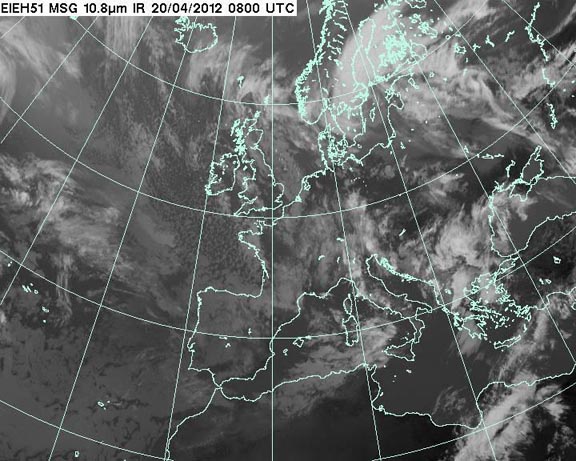
as higher altitude cloud and this led to the decision to fly to Stuttgart EDDS instead, which lies about 100nm to the north of Friedrichshafen EDNY.
On these images, the whiter the cloud is the lower its temperature and thus the greater its altitude. High altitude cloud, say FL200 plus, shows up as something approaching solid white (e.g. Norway/Sweden in the pic above). IR imagery which contains a temperature scale (enabling a more accurate altitude estimate; if necessary by reference to altitude/temperature data which for some reason is a lot more accurate) does exist but I have not found any which is less than several hours old... I therefore use experience to judge where the cloud tops might lie. For example the grey in the Pyrenees region is probably around FL150-180 and given that my aircraft can climb to FL190-200, this is not a problem if it is to be encountered enroute, after one has had a chance to climb up. I am not aware of any more precise way of doing it and to a large degree one is relying on the aircraft having a reasonable operating ceiling. I would be doing this in a C152.
Some notes on this type of cloud tops forecasting are here.
Additional factors in the decision to go to EDDS were:
1. The parking options at EDNY, for "light" aircraft, tend to be grass or bad grass, and given the amount of recent rain there is a real risk of a 1400kg aircraft getting bogged down. Last time we ended up on rough grass there were 3 of us and together we managed to push it out onto the nearest tarmac taxiway, thus avoiding a risk of a prop strike, but this time there were just 2 of us. It is apparently possible to firmly but politely ask for hard parking, however.
2. Due to the early closing time at our home base (Shoreham EGKA) of 1730 UTC, we had to fly back the following day, which would be a day after the show closed, and getting help from bystanders is difficult since there are not many people around then.
3. For the first time, the online slot booking website operated by the show organisers imposed an outright ban on IFR arrivals below 1600kg. Together with the legendary arrogance of some ATCOs at EDNY I did not want to end up doing silly antics over the lake near the airport, trying to get in "VFR". As it happens, ATC don't seem to operate the < 1600kg IFR ban but I didn't know that at the time.
4. A group of German friends agreed to also fly to Stuttgart and rent a car there. The cost of a car is partly offset by being able to stay in a much cheaper hotel, further away, and the avoidance of taxi fares.
5. Due to the suspect weather, one must consider the possibility of having to abandon the aircraft, and there are no longer any direct flights between EDNY and the UK, so getting back, and then getting out there to collect the aircraft, would be a huge hassle, costing about £1000 in airline tickets, related transport, and probably 1 night in a hotel before the aircraft recovery flight back to the UK.
Despite the apparently better weather at EDDS, the TAFs were quite similar for EDDS and EDNY
TAF EDDS 200500Z 2006/2106 23005KT 9999 SCT030 BKN045
TEMPO 2010/2018 SHRA BKN020CB
PROB30 TEMPO 2012/2017 TSRA=
TAF EDNY 200500Z 2006/2106 VRB02KT 9999 SCT040
BECMG 2007/2009 23007KT
PROB30 TEMPO 2011/2018 4000 TSRA BKN040CB
BECMG 2018/2020 VRB03KT=
For the return flight, the weather looked very similar. I cancel a lot of trips due to return weather issues because the instrument approaches at Shoreham have a high MDH (in prevailing winds, runway 20, 800ft) and thus poor utility for getting back home. Also, as in 2010, the DME was out of service which takes out the instrument approach to 20, leaving the 02 and a circle to land to 20 only. There is a GPS approach but this has the same 800ft MDH and thus offers no greater utility.
Other weather information which was examined was the 1200 SigWx whose Area 13 tended to confirm that EDNY weather would be worse than EDDS. However, following recent changes the SigWx chart is much less useful to non-deiced pilots. Contrary to widespread belief, it does not show cloud tops, and ICAO recently made them even less useful by suppressing information which might be used to derive cloud tops data if there are any CBs forecast in the same area, which is exactly what Area 13 shows! The Sferics picture confirmed that there was hardly any lightning around, which is always a good thing. The radar picture showed scattered buildups which confirmed the general picture.
For a non-deiced aircraft (I have only a TKS de-iced propeller) one should not get into a situation where one may collect too much ice which one cannot melt off during flight. In the departure phase this is best covered by maintaining VMC during the climb, but that option may not be present on arrival because there is no way of knowing what kind of IMC will be hanging around there. METARs report only cloud below 5000ft above the airport, or up to the MSA if this is higher than 5000ft, so a descent from high altitude could encounter freezing cloud which is unverifiable in advance. In this case, the surface temperatures were adequately above freezing so any ice collected on the way down could be melted off before landing.
Preflight Procedures
IFR route design: The Eurocontrol (often interchangeably called CFMU or IFPS) IFR routings were generated and validated online in just minutes using FlightPlanPro (FPP). This routing tool has revolutionalised European IFR route development. It generates an initial route from its internal airway database; the route is submitted to Eurocontrol for validation (internet access is required) and is iteratively modified.
Things have come a long way since I first started doing this in 2005 and the only facility available to GA pilots was an anonymous Italian website - ostensibly for flight simulator enthusiasts - which produced half-baked routings which usually needed extra hacking to get them accepted. Eurocontrol did their best to make route development accessible only to the bizjet flight support services (Jeppesen etc) but eventually the now-defunct Autoplan came along in 2008 and forced their hand...
I then paste the validated airway route into Jeppesen Flitestar, from which
the plogs and other material (e.g. enroute chart sections) are printed out.
Provided that the flight is executed on more or less the filed route (plus or
minus say 100nm either side) there is no need to ever open the unwieldy printed
airway chart in the cockpit. This
trip report shows my workflow in detail, but actually there are numerous
other ways of doing the same thing and some pilots just rely on saving the route
data on an Ipad and hope it keeps working ![]() The following route pics are screenshots from Flitestar.
The following route pics are screenshots from Flitestar.
The outbound route:
EGKA
WIZAD M140 DVR L9 KONAN L607 RUDUS Z738 UBENO N850 KRH T128 BADSO
EDDS
FL150
390 nm (GC) 445nm (airways)
Alternates: EDNY, EDFM
The filed level was FL150. The exact level does not matter; one can vary it according to weather. Normally I file for FL140/150 or higher as this yields better routings than lower down.
The return route:
EDDS
ROTWE Y126 LUPEN R7 GTQ DCT MTZ DCT MMD M163 SUIPE H9 REM B3 BILGO H20 XORBI
H40 ABB T27 KUNAV Y8 BANVA
EGKA
FL150
390 nm (GC) 430nm (airways)
Alternates: EGHH (Bournemouth), EGMD (Lydd)
PPR (prior permission required) is an issue at EDDS - you need an airport slot - but the handling agent deals with it. My German friends sorted it out. The easiest way to sort out the slot is to call AIS in Germany at +49 69 78072500 and ask for a slot. They will give you a number right away, free of charge which you enter as ASL/xxxxxx in the remarks box of your flight plan. I didn't do that, and some pilots have received letters from the "Slot Coordinator of the Federal Republic of Germany" accusing them of a violation and threatening a hefty fine (4-5 digits). It is only a threat...
Flight plan filing was done electronically, at zero cost, using EuroFPL for both legs. Today there are several ways of doing this but I continue to use EuroFPL because it is a data-efficient website which is usable over a slow GPRS/3G connection, works on my Nokia 700 phone, has a flight tracking facility which enables someone on the ground to monitor your progress, and (in the paid-for version) offers SMS facilities for delaying or cancelling the flight plan. I retain the free AFPEx site (available only to pilots with a UK address) as a backup system. More notes on electronic flight plan filing options are here.
Note: the Eurocontrol routings given here and elsewhere will most likely not work by the time you might try them because the precise form needed to get the route into the Eurocontrol (IFPS) computer in Brussels changes from one week to the next, and there are frequent differences between weekdays and weekends which are largely due to a lack of military activity on weekends.
Fuel Planning
Fuel was not an issue on this flight, involving around 40% of the aircraft zero-fuel range. One could fly all the way back to Shoreham if absolutely necessary...
Oxygen
In IFR, oxygen is as vital a flight planning issue as fuel. This flight was filed for FL150 and oxygen is practically and legally mandatory. Anyway, I never fly anywhere IFR without oxygen because doing so nearly halves the aircraft operating ceiling and discards by far the most attractive weather avoidance option: climbing to VMC on top. I also use oxygen anytime at/above FL100; the flow rate at FL100 is very low but it keeps you fresh and you don't arrive tired.
Oxygen turned out to be a bit of a problem on this trip, as I describe later...
The Flight
The Shoreham (Class G) departure clearance was: After departure left turn to SFD, remain outside controlled airspace, squawk 1172, contact London Control 133.175.
The initial base of controlled airspace in the area is 5500ft so one sets 5400ft as the target level on the autopilot...
There was a lot of thick cloud around but a clear path up through it was readily apparent
Had this not been there, I would have considered going anyway because the surface temperature was +11C which together with the general cloudbase of 1500ft provided a decent escape route (descend, wait for it to melt, and either have another go or land) should excessive ice be collected on the way up.
On first contact, London Control asked for the customary squawk ident and then issued a clearance to enter controlled airspace, with a climb to FL100 on present track. Shortly afterwards they authorised a climb to FL140. I could see some high cloud ahead
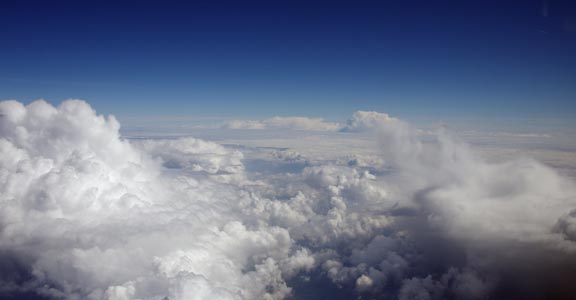
so asked for higher and rapidly got FL170, and later from Brussels got FL180, and FL190. We managed to just stay above the white stuff.
However it became apparent that the Precise Oxygen mechanical demand regulators were not really up to the job. I had problems keeping my own blood oxygen above 90% which is really the minimum figure. I had one passenger; my 16 year old son, and his level was dropping to around 85% which is unacceptable if one is going to be awake. He also had a tendency to breathe through his mouth so I gave him a mask. I turned the flow all the way up - we had a large 48 cu. ft cylinder, with a spare one in the back of the aircraft - and this enabled us both to maintain about 90%, but at FL180/190 it was a bit of a struggle. I had been to those levels on numerous previous occassions and had noted a need for deliberate breathing, but this time I got really fed up with it.
I decided to upgrade the oxygen system to the pricey but much more effective Mountain High O2D2 electronic demand regulator system which I had tested some time ago; preferably by buying the O2D2 at the show so we had it for the return trip.
The descent into EDDS involved a lot of heavy cloud and as expected we picked up ice rapidly at times, with about 5mm accreting in just a few seconds at one point. With a surface temperature (from the ATIS) of +9C this was not a real hazard. We got rain, sleet, more rain, more sleet, and alarmingly some rain was found at 0C which was a borderline "freezing rain" scenario. None of it was freezing however so the actual airframe temperature was probably +0.5C or so. I would like an OAT probe that indicates to 0.1C but I know of no certified instruments that do that, for GA, and anyway aerodynamic heating varies a lot around the airframe even at these low speeds. This was at 5000ft. I reported "freezing rain" to ATC and asked for an immediate descent, which they initially refused saying that 5000ft is the lowest radar altitude, but later offered a descent to the MSA (probably about 3000ft). Had any of it started to stick I would have instantly descended anyway regardless... I had the German VFR chart running as a GPS moving map on the LS800 tablet computer so could see the general and spot elevations in the area. ATC cannot provide vectoring below their MRVA but there is a second issue: in the event that one descended below the base of Class E, IFR in Class G (outside controlled airspace) is illegal in Germany so ATC cannot openly authorise it, so it is advisable to declare an emergency in situations like this as it covers them legally, and prevents a criminal action against the pilot.
VMC was reached around 4000ft, with plenty of rain all around but at about +1C so OK
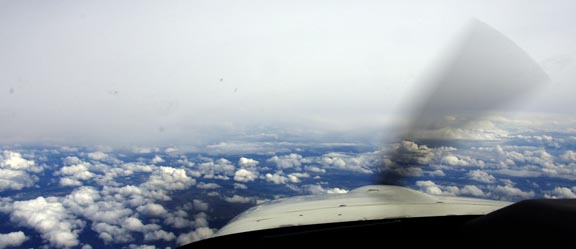
The final approach into EDDS was through more heavy rain
We apparently landed shortly after a huge downpour so the airport became a hive of departure activity as a long queue of commercial operators tried to get out
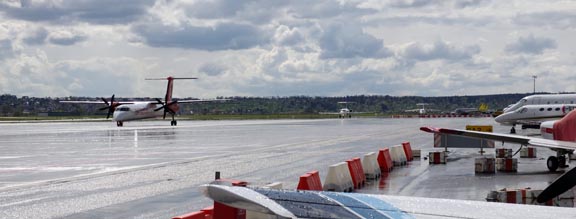
Some interesting registrations...
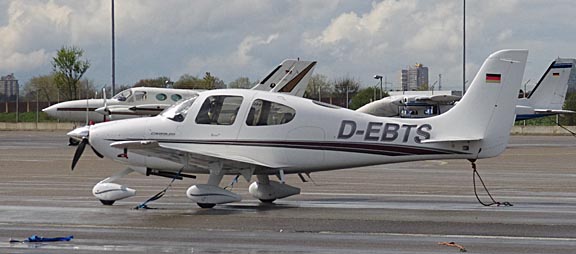
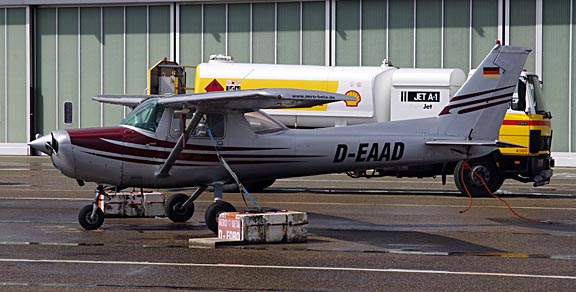
I have a picture of something called D-EATH above my desk at work so this seems
to be a pattern in Germany ![]()
This was the weather which just passed
We were met by the handling van immediately. I requested Avgas and the Avgas truck turned up within a few minutes. At €2.76/litre, the price was at the top end of the EU price range. The total cost of landing and 2 nights' parking was €125.21 (1400kg; including €10.60 passenger duty and € "landing service charge") which is workable for a very occassional visit but will kill off any regular GA activity unless they find a way to get around this pricing. I don't really think the Cessna above pays that every time it flies... Long term outdoors parking at EDDS is about €350/month and a landing is about €40 for the locals. Stuttgart is one of very few large airports that accepts GA; Frankfurt and Munich charge around €500.
We stayed at a nice but inexpensive hotel about 30km away from the show, which is highly advisable to avoid the totally ripoff pricing of those within walking distance. It had a pretty good view
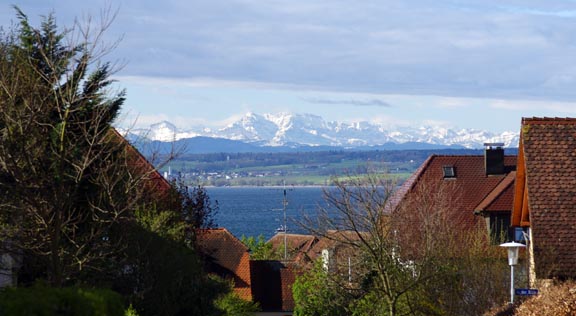
The Show
The show has something for everyone, including radio control models. In GA terms, the stuff ranges from a huge selection of what I loosely call "ultralight/sports/homebuilt" types (most of which are exhibited to gauge market reaction and are sure to never make production), through to the lighter end of certified GA, with the traditional very small selection of piston IFR touring aircraft (Piper, Cessna, Cirrus, Diamond basically) and then the usual turboprops like the Pilatus PC12 and the TBM850
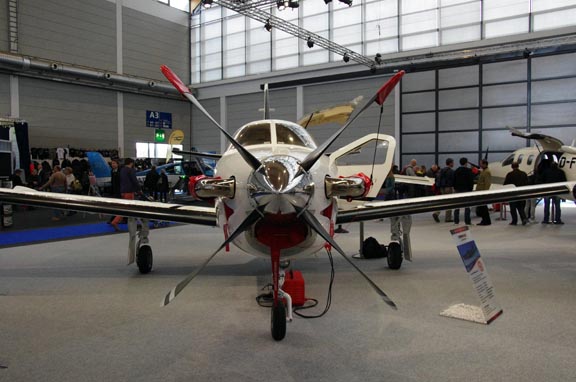
and finally a number of light jets.
One really interesting new aircraft was the Pipistrel Panthera
This is a new 4-seater design which breaks the tradition with a highly aerodynamic shape, retractable gear which uses a very well engineered trailing link mechanism made from a lot of titanium, a Lycoming IO-390 engine, and reasonably sized fuel tanks to deliver a projected 200kt cruise speed with a 1000nm+ zero-fuel range. With a 1200kg MTOW its payload is up there with the most capable GA 4-seaters like the TB20. The cockpit is very well designed and is spacious enough for 6ft+ occupants
They plan to sell it in a VFR model with Dynon avionics, and an IFR model with Garmin avionics which were partly installed in this one, with a GTN650/GTN750 in the centre stack
The aircraft on show was the one which will actually fly, and for something at that stage of development it was very well finished. I was very impressed with the overall engineering which is a long way from other IFR 4-seatter attempts like the now defunct Evektor Cobra.
There were many new engine prototypes on display, but there always are... looking for someone to sink a few million into the venture. Mistral were there with their Wankel engine, same as last year and the year before that...
A hot topic this year was the use of unleaded avgas in traditionally 100LL-only engines. TOTAL (France) have been pushing their 91UL fuel hard in the UK, in what some see as a cynical market share grab which may kill off 100LL availability at many airfields and cause huge problems for owners with turbocharged engines which are unlikely to be certified for 91UL for a long time, if ever. Lycoming are gradually extending the list of engines approved for 91UL and apparently my IO540-C4 will be on the list very soon. Since 91UL is "avgas" with the lead additive removed, there appears to be no issue with aircraft fuel system materials. Unofficially, it appears that the incompatibility risk (which is basically a detonation risk) in the higher compression engines is in fact not an issue provided the engine is properly instrumented and the CHTs are kept down to reasonable levels.
After some considerable walking around I located a source for the Mountain High O2D2 oxygen regulator and bought the only one they had...
The show was interesting as always to walk around the whole lot, though more for meeting up with friends around Europe than for seeing new stuff, of which there was very little.
The year-on-year decline in attendance, since my first visit in 2007, was also clearly visible. The exhibitors attributed this to the show being every year instead of every two, which reduces visitor numbers and also reduces exhibitor numbers because the stands are very expensive so the smaller ones drop out. On the plus side, some exhibitors reported an improvement in the quality of sales leads.
The general area is worth spending an extra day or two in
The Return Flight
The MSLP charts 0600 1200 1800 showed weather similar to the outbound flight, with a worsening near the point of departure. The SigWx showed more ambiguous stuff but again any area with CBs forecast delivers no information on other weather. The TAFs confirmed the weather out could see by looking up at the sky...
The really relevant data for the enroute section was the IR satellite image which showed cloup tops that looked like they could be overflown.
The sferics picture showed quite a lot of TS activity. For fun I also got this icing forecast (from the USAF in Germany) which showed next to nothing, which was clearly bogus.
The drive from the hotel to Stuttgart airport took about 2hrs and the later
part of it was in rain so heavy we could barely see. This was rather depressing
as it was obviously over a huge area. The following days' forecast was even
worse, with frontal activity as well. I started checking out airline options
but the cheapest one for the two of us was €800 via BA to Heathrow... The
choice of Stuttgart for its airline accessibility was perhaps not the best choice
after all ![]()
The hire car is returned to the main terminal and then one telephones the GAT Handling (0049 711 948 3482) who collect you with a van; the walk to GA is very long. As we got there, patches of blue sky started to appear and given the runway direction (25) and the departure direction (close to 250) it looked like one could head up through one of the holes, in a continuous climb to at least FL150. I got the flight plan (which had been filed in advance before the trip) moved back by 3 hours, to present time plus just 30 minutes. This is always a bit risky because it involves cancelling the flight plan and filing a new one, with the possibility of triggering a Eurocontrol slot or even an outright rejection of the route which validated OK a few days previously. However the GA handler did it immediately. We paid up and went straight off.
It's worth noting that the way the GA parking is arranged at EDDS, the aircraft has to be pushed backwards onto the taxiway. One cannot just taxi out. The parking is also dense and some maneuvering with the towbar may be needed to avoid others' wingtips. With a heavy aircraft and just one person available, this is something to consider... However I understand that the handlers offer help with this.
The allocated SID was ROTWE4B but to hit the hole in the sky I simply told ATC that due weather I required a left 40 degrees turn after departure, which they agreed to. This worked out OK
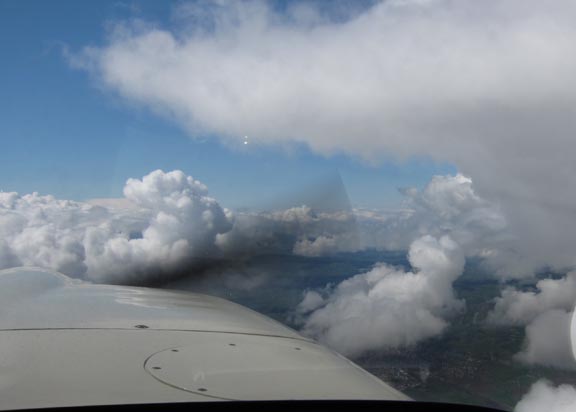
This is FL100
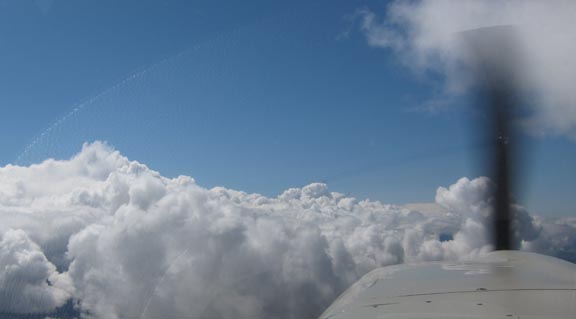
and this is about FL180 which takes 30 mins to reach
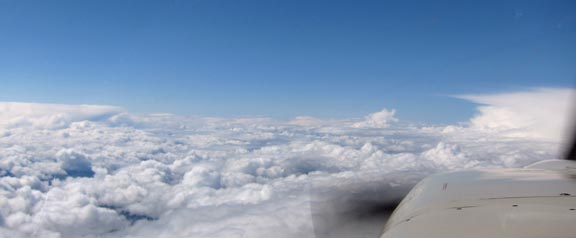
Climbing to FL200 takes a while and the slightest downdraught kills the climb
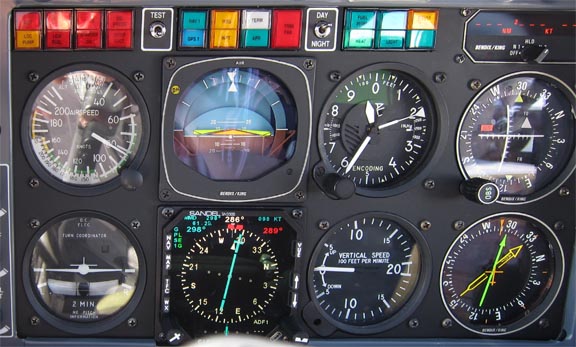
This weather was typical of the route at FL200 where we were only just skimming the tops of the TCUs
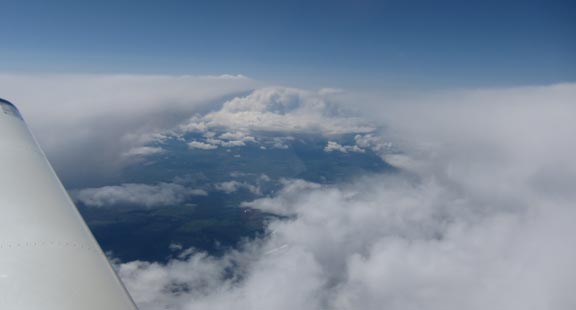
The temperature at FL200 was ISA-9
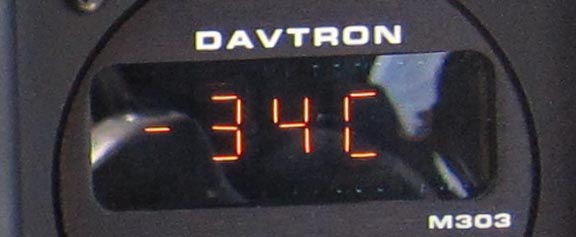
which helped the performance, delivering a respectable 100kt IAS up there
The O2D2 oxygen regulator performed brilliantly and we were both getting over 95% at FL200, on cannulas, which is simply amazing. The unit senses the start of the inhalation cycle very accurately and squirts the oxygen in at just the right moment. The O2D2 regulator, in a kit with 4 cannulas, is US$800.
As always, I asked for shortcuts and got some reasonable ones. The most unusual one was from MMD to BILGO which is normally impossible but presumably on Sundays the military are not working.
Finally, over the Channel the cloud thinned out
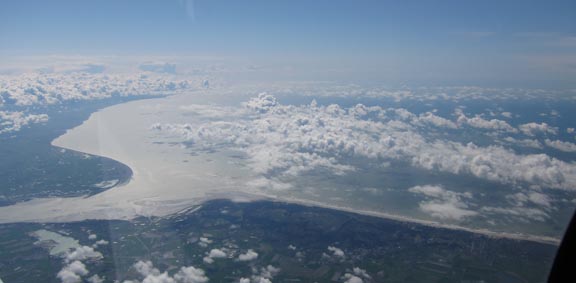
We asked for a descent initially to FL180 and then got handed to London Control who gave us a DCT to Shoreham (93nm) but asked for a -1000fpm descent to FL120. I said I was unable to comply due to my son having problems clearing one of his ears. ATC were OK with that and we continued at -300fpm most of the way down, with some heading changes.
London Control advised me that the instrument approach at Shoreham was out of action (which I knew - duff NDB) but the flight ended in good VFR conditions.
The vertical profile of the track flown is below
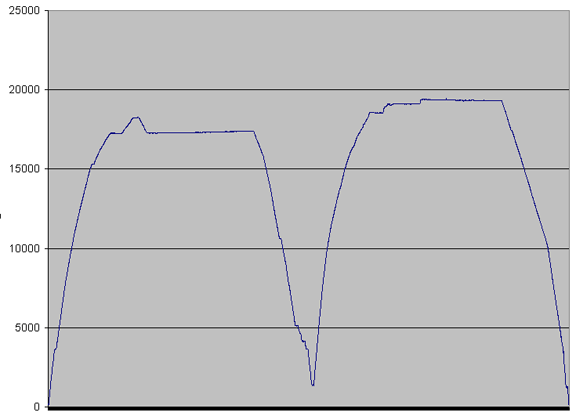
The QNH was well below 1013 everywhere so the altitude at FL200 was well below 20,000ft.
The route flown is here

The map is a very old Cold War one which is the only one I have that covers the entire area in one piece.
This trip would probably have been possible under VFR but there would have been a lot of downpours (TCU and CB bases) to avoid along the way. In places it would have been unsafe to continue, I think.
ATC were entirely professional and helpful.
The aircraft performed perfectly. Some notes on Socata TB20 ownership and operation are here.
Update 19/5/2012
I received a bill for 16.23 euros from the German DFS for "terminal air navigation". This includes a charge of 0.40 euro for "German meteorological services". These bills can be a right hassle because most of them can be paid only with a bank transfer, which can easily cost a foreign pilot 20-30 euros in bank charges, and often the airport allocates the payment to the wrong invoice, but this one was payable with a credit card too.
Pilot: FAA CPL/IR + JAA PPL/IR, approx 1500 hours.
Any feedback, reports of dead links, corrections or suggestions much appreciated:
Contact details
This page last edited 19th May 2012